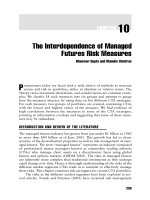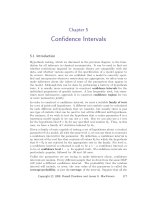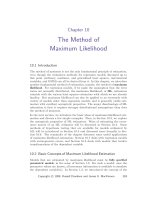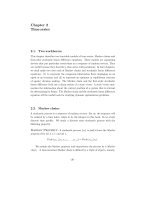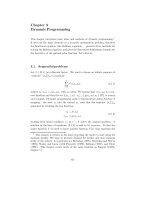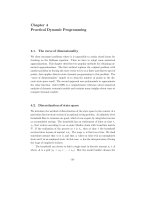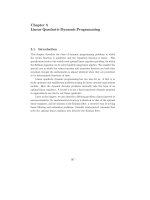Recursive macroeconomic theory, Thomas Sargent 2nd Ed - Chapter 10 pps
Bạn đang xem bản rút gọn của tài liệu. Xem và tải ngay bản đầy đủ của tài liệu tại đây (143.96 KB, 11 trang )
Chapter 10
Ricardian Equivalence
10.1. Borrowing limits and Ricardian equivalence
This chapter studies whether the timing of taxes matters. Under some assump-
tions it does, and under others it does not. The Ricardian doctrine describes
assumptions under which the timing of lump taxes does not matter. In this
chapter, we will study how the timing of taxes interacts with restrictions on the
ability of households to borrow. We study the issue in two equivalent settings:
(1) an infinite horizon economy with an infinitely lived representative agent; and
(2) an infinite horizon economy with a sequence of one-period-lived agents, each
of whom cares about its immediate descendant. We assume that the interest
rate is exogenously given. For example, the economy might be a small open
economy that faces a given interest rate determined in the international capital
market. Chapter 13 will describe a general equilibrium analysis of the Ricardian
doctrine where the interest rate is determined within the model.
The key findings of the chapter are that in the infinite horizon model, Ri-
cardian equivalence holds under what we earlier called the natural borrowing
limit, but not under more stringent ones. The natural borrowing limit is the
one that lets households borrow up to the capitalized value of their endow-
ment sequences. These results have counterparts in the overlapping generations
model, since that model is equivalent to an infinite horizon model with a no-
borrowing constraint. In the overlapping generations model, the no-borrowing
constraint translates into a requirement that bequests be nonnegative. Thus,
in the overlapping generations model, the domain of the Ricardian proposition
is restricted, at least relative to the infinite horizon model under the natural
borrowing limit.
– 306 –
Infinitely lived–agent economy 307
10.2. Infinitely lived–agent economy
An economy consists of N identical households each of whom orders a stream
of consumption of a single good with preferences
∞
t=0
β
t
u(c
t
), (10.2.1)
where β ∈ (0, 1) and u(·) is a strictly increasing, strictly concave, twice-
differenti-
able one-period utility function. We impose the Inada condition
lim
c↓0
u
(c)=+∞.
This condition is important because we will be stressing the feature that c ≥ 0.
There is no uncertainty. The household can invest in a single risk-free asset
bearing a fixed gross one-period rate of return R>1. The asset is either a
risk-free loan to foreigners or to the government. At time t, the household faces
the budget constraint
c
t
+ R
−1
b
t+1
≤ y
t
+ b
t
, (10.2.2)
where b
0
is given. Throughout this chapter, we assume that Rβ =1. Here
{y
t
}
∞
t=0
is a given nonstochastic nonnegative endowment sequence and
∞
t=0
β
t
y
t
< ∞.
We shall investigate two alternative restrictions on asset holdings {b
t
}
∞
t=0
.
One is that b
t
≥ 0 for all t ≥ 0. This restriction states that the household
can lend but not borrow. The alternative restriction permits the household to
borrow, but only an amount that it is feasible to repay. To discover this amount,
set c
t
=0 forall t in formula (10.2.2) and solve forward for b
t
to get
˜
b
t
= −
∞
j=0
R
−j
y
t+j
, (10.2.3)
where we have ruled out Ponzi schemes by imposing the transversality condition
lim
T →∞
R
−T
b
t+T
=0. (10.2.4)
Following Aiyagari (1994), we call
˜
b
t
the natural debt limit.Evenwithc
t
=0,
the consumer cannot repay more than
˜
b
t
. Thus, our alternative restriction on
assets is
b
t
≥
˜
b
t
, (10.2.5)
308 Ricardian Equivalence
which is evidently weaker than b
t
≥ 0.
1
10.2.1. Solution to consumption/savings decision
Consider the household’s problem of choosing {c
t
,b
t+1
}
∞
t=0
to maximize ex-
pression (10.2.1) subject to (10.2.2) and b
t+1
≥ 0 for all t. The first-order
conditions for this problem are
u
(c
t
) ≥ βRu
(c
t+1
), ∀t ≥ 0; (10.2.6a)
and
u
(c
t
) >βRu
(c
t+1
) implies b
t+1
=0. (10.2.6b)
Because βR = 1, these conditions and the constraint (10.2.2) imply that c
t+1
=
c
t
when b
t+1
> 0; but when the consumer is borrowing constrained, b
t+1
=0
and y
t
+ b
t
= c
t
<c
t+1
. The solution evidently depends on the {y
t
} path, as
the following examples illustrate.
Example 1 Assume b
0
= 0 and the endowment path {y
t
}
∞
t=0
= {y
h
,y
l
,y
h
,y
l
, },
where y
h
>y
l
> 0. The present value of the household’s endowment is
∞
t=0
β
t
y
t
=
∞
t=0
β
2t
(y
h
+ βy
l
)=
y
h
+ βy
l
1 − β
2
.
The annuity value ¯c that has the same present value as the endowment stream
is given by
¯c
1 − β
=
y
h
+ βy
l
1 − β
2
, or ¯c =
y
h
+ βy
l
1+β
.
The solution to the household’s optimization problem is the constant consump-
tion stream c
t
=¯c for all t ≥ 0, and using the budget constraint (10.2.2), we
can back out the associated savings scheme; b
t+1
=(y
h
− y
l
)/(1 + β) for even
t,andb
t+1
=0 forodd t. The consumer is never borrowing constrained.
2
1
We encountered a more general version of equation (10.2.5) in chapter 8
when we discussed Arrow securities.
2
Note b
t
= 0 does not imply that the consumer is borrowing constrained.
He is borrowing constrained if the Lagrange multiplier on the constraint b
t
≥ 0
is not zero.
Government 309
Example 2 Assume b
0
= 0 and the endowment path {y
t
}
∞
t=0
= {y
l
,y
h
,y
l
,y
h
, },
where y
h
>y
l
> 0. The solution is c
0
= y
l
and b
1
=0,andfromperiod1
onward, the solution is the same as in example 1. Hence, the consumer is bor-
rowing constrained the first period.
3
Example 3 Assume b
0
=0andy
t
= λ
t
where 1 <λ<R.Noticethat
λβ < 1. The solution with the borrowing constraint b
t
≥ 0isc
t
= λ
t
,b
t
=0
for all t ≥ 0. The consumer is always borrowing constrained.
Example 4 Assume the same b
0
and endowment sequence as in example 3,
but now impose only the natural borrowing constraint (10.2.5). The present
value of the household’s endowment is
∞
t=0
β
t
λ
t
=
1
1 − λβ
.
The household’s budget constraint for each t is satisfied at a constant consump-
tion level ˆc satisfying
ˆc
1 − β
=
1
1 − λβ
, or ˆc =
1 − β
1 − λβ
.
Substituting this consumption rate into formula (10.2.2) and solving forward
gives
b
t
=
1 − λ
t
1 − βλ
. (10.2.7)
The consumer issues more and more debt as time passes, and uses his rising
endowment to service it. The consumer’s debt always satisfies the natural debt
limit at t,namely,
˜
b
t
= −λ
t
/(1 − βλ).
Example 5 Take the specification of example 4, but now impose λ<1. Note
that the solution (10.2.7) implies b
t
≥ 0, so that the constant consumption
path c
t
=ˆc in example 4 is now the solution even if the borrowing constraint
b
t
≥ 0isimposed.
3
Examples 1 and 2 illustrate a general result in chapter 16. Given a bor-
rowing constraint and a non-stochastic endowment stream, the impact of the
borrowing constraint will not vanish until the household reaches the period with
the highest annuity value of the remainder of the endowment stream.
310 Ricardian Equivalence
10.3. Government
Add a government to the model. The government purchases a stream {g
t
}
∞
t=0
per household and imposes a stream of lump-sum taxes {τ
t
}
∞
t=0
on the house-
hold, subject to the sequence of budget constraints
B
t
+ g
t
= τ
t
+ R
−1
B
t+1
, (10.3.1)
where B
t
is one-period debt due at t, denominated in the time t consumption
good, that the government owes the households or foreign investors. Notice
that we allow the government to borrow, even though in one of the preceding
specifications, we did not permit the household to borrow. (If B
t
< 0, the
government lends to households or foreign investors.) Solving the government’s
budget constraint forward gives the intertemporal constraint
B
t
=
∞
j=0
R
−j
(τ
t+j
− g
t+j
)(10.3.2)
for t ≥ 0, where we have ruled out Ponzi schemes by imposing the transversality
condition
lim
T →∞
R
−T
B
t+T
=0.
10.3.1. Effect on household
We must now deduct τ
t
from the household’s endowment in (10.2.2),
c
t
+ R
−1
b
t+1
≤ y
t
− τ
t
+ b
t
. (10.3.3)
Solving this tax-adjusted budget constraint forward and invoking transversality
condition (10.2.4) yield
b
t
=
∞
j=0
R
−j
(c
t+j
+ τ
t+j
− y
t+j
). (10.3.4)
The natural debt limit is obtained by setting c
t
=0 forall t in (10.3.4),
˜
b
t
≥
∞
j=0
R
−j
(τ
t+j
− y
t+j
). (10.3.5)
Government 311
Notice how taxes affect
˜
b
t
[compare equations (10.2.3) and (10.3.5)].
We use the following definition:
Definition: Given initial conditions (b
0
,B
0
), an equilibrium is a household
plan {c
t
,b
t+1
}
∞
t=0
and a government policy {g
t
,τ
t
,B
t+1
}
∞
t=0
such that (a) the
government plan satisfies the government budget constraint (10.3.1), and (b)
given {τ
t
}
∞
t=0
, the household’s plan is optimal.
We can now state a Ricardian proposition under the natural debt limit.
Proposition 1: Suppose that the natural debt limit prevails. Given initial
conditions (b
0
,B
0
), let {¯c
t
,
¯
b
t+1
}
∞
t=0
and {¯g
t
, ¯τ
t
,
¯
B
t+1
}
∞
t=0
be an equilibrium.
Consider any other tax policy {ˆτ
t
}
∞
t=0
satisfying
∞
t=0
R
−t
ˆτ
t
=
∞
t=0
R
−t
¯τ
t
. (10.3.6)
Then {¯c
t
,
ˆ
b
t+1
}
∞
t=0
and {¯g
t
, ˆτ
t
,
ˆ
B
t+1
}
∞
t=0
is also an equilibrium where
ˆ
b
t
=
∞
j=0
R
−j
(¯c
t+j
+ˆτ
t+j
− y
t+j
)(10.3.7)
and
ˆ
B
t
=
∞
j=0
R
−j
(ˆτ
t+j
− ¯g
t+j
). (10.3.8)
Proof: The first point of the proposition is that the same consumption plan
{¯c
t
}
∞
t=0
, but adjusted borrowing plan {
ˆ
b
t+1
}
∞
t=0
, solve the household’s optimum
problem under the altered government tax scheme. Under the natural debt limit,
the household in effect faces a single intertemporal budget constraint (10.3.4).
At time 0, the household can be thought of as choosing an optimal consumption
plan subject to the single constraint,
b
0
=
∞
t=0
R
−t
(c
t
− y
t
)+
∞
t=0
R
−t
τ
t
.
Thus, the household’s budget set, and therefore its optimal plan, does not de-
pend on the timing of taxes, only their present value. The altered tax plan
leaves the household’s intertemporal budget set unaltered and therefore doesn’t
312 Ricardian Equivalence
affect its optimal consumption plan. Next, we construct the adjusted borrow-
ing plan {
ˆ
b
t+1
}
∞
t=0
by solving the budget constraint (10.3.3) forward to obtain
(10.3.7).
4
The adjusted borrowing plan satisfies trivially the (adjusted) natural
debt limit in every period, since the consumption plan {¯c
t
}
∞
t=0
is a nonnegative
sequence.
The second point of the proposition is that the altered government tax
and borrowing plans continue to satisfy the government’s budget constraint. In
particular, we see that the government’s budget set at time 0 does not depend
on the timing of taxes, only their present value,
B
0
=
∞
t=0
R
−t
τ
t
−
∞
t=0
R
−t
g
t
.
Thus, under the altered tax plan with an unchanged present value of taxes,
the government can finance the same expenditure plan {¯g
t
}
∞
t=0
.Theadjusted
borrowing plan {
ˆ
B
t+1
}
∞
t=0
is computed in a similar way as above to arrive at
(10.3.8).
4
It is straightforward to verify that the adjusted borrowing plan {
ˆ
b
t+1
}
∞
t=0
must satisfy the transversality condition (10.2.4). In any period (k − 1) ≥ 0,
solving the budget constraint (10.3.3) backward yields
b
k
=
k
j=1
R
j
[y
k−j
− τ
k−j
− c
k−j
]+R
k
b
0
.
Evidently, the difference between
¯
b
k
of the initial equilibrium and
ˆ
b
k
is equal
to
¯
b
k
−
ˆ
b
k
=
k
j=1
R
j
[ˆτ
k−j
− ¯τ
k−j
] ,
and after multiplying both sides by R
1−k
,
R
1−k
¯
b
k
−
ˆ
b
k
= R
k−1
t=0
R
−t
[ˆτ
t
− ¯τ
t
] .
The limit of the right side is zero when k goes to infinity due to condition
(10.3.6), and hence, the fact that the equilibrium borrowing plan {
¯
b
t+1
}
∞
t=0
satisfies transversality condition (10.2.4) implies that so must {
ˆ
b
t+1
}
∞
t=0
.
Government 313
This proposition depends on imposing the natural debt limit, which is
weaker than the no-borrowing constraint on the household. Under the no-
borrowing constraint, we require that the asset choice b
t+1
at time t both
satisfies budget constraint (10.3.3) and does not fall below zero. That is, under
the no-borrowing constraint, we have to check more than just a single intertem-
poral budget constraint for the household at time 0. Changes in the timing
of taxes that obey equation (10.3.6 ) evidently alter the right side of equation
(10.3.3) and can, for example, cause a previously binding borrowing constraint
no longer to be binding, and vice versa. Binding borrowing constraints in either
the initial {¯τ
t
}
∞
t=0
equilibrium or the new {ˆτ
t
}
∞
t=0
equilibria eliminates a Ri-
cardian proposition as general as Proposition 1. More restricted versions of the
proposition evidently hold across restricted equivalence classes of taxes that do
not alter when the borrowing constraints are binding across the two equilibria
being compared.
Proposition 2: Consider an initial equilibrium with consumption path
{¯c
t
}
∞
t=0
in which b
t+1
> 0 for all t ≥ 0. Let {¯τ
t
}
∞
t=0
be the tax rate in the
initial equilibrium, and let {ˆτ
t
}
∞
t=0
be any other tax-rate sequence for which
ˆ
b
t
=
∞
j=0
R
−j
(¯c
t+j
+ˆτ
t+j
− y
t+j
) ≥ 0
for all t ≥ 0. Then {¯c
t
}
∞
t=0
is also an equilibrium allocation for the {ˆτ
t
}
∞
t=0
tax
sequence.
We leave the proof of this proposition to the reader.
314 Ricardian Equivalence
10.4. Linked generations interpretation
Much of the preceding analysis with borrowing constraints applies to a setting
with overlapping generations linked by a bequest motive. Assume that there is
a sequence of one-period-lived agents. For each t ≥ 0 there is a one-period-lived
agent who values consumption and the utility of his direct descendant, a young
person at time t + 1. Preferences of a young person at t are ordered by
u(c
t
)+βV (b
t+1
),
where u(c) is the same utility function as in the previous section, b
t+1
≥ 0
are bequests from the time-t person to the time–t +1 person,and V (b
t+1
)is
the maximized utility function of a time–t + 1 agent. The maximized utility
function is defined recursively by
V (b
t
)= max
c
t
,b
t+1
{u(c
t
)+βV (b
t+1
)}
∞
t=0
(10.4.1)
where the maximization is subject to
c
t
+ R
−1
b
t+1
≤ y
t
− τ
t
+ b
t
(10.4.2)
and b
t+1
≥ 0. The constraint b
t+1
≥ 0 requires that bequests cannot be
negative. Notice that a person cares about his direct descendant, but not vice
versa. We continue to assume that there is an infinitely lived government whose
taxes and purchasing and borrowing strategies are as described in the previous
section.
In consumption outcomes, this model is equivalent to the previous model
with a no-borrowing constraint. Bequests here play the role of savings b
t+1
in the previous model. A positive savings condition b
t+1
> 0 in the previous
version of the model becomes an “operational bequest motive” in the overlapping
generations model.
It follows that we can obtain a restricted Ricardian equivalence proposition,
qualified as in Proposition 2. The qualification is that the initial equilibrium
must have an operational bequest motive for all t ≥ 0, and that the new tax
policy must not be so different from the initial one that it renders the bequest
motive inoperative.
Concluding remarks 315
10.5. Concluding remarks
The arguments in this chapter were cast in a setting with an exogenous interest
rate R and a capital market that is outside of the model. When we discussed
potential failures of Ricardian equivalence due to households facing no-borrowing
constraints, we were also implicitly contemplating changes in the government’s
outside asset position. For example, consider an altered tax plan {ˆτ
t
}
∞
t=0
that
satisfies (10.3.6) and shifts taxes away from the future toward the present. A
large enough change will definitely ensure that the government is a lender in
early periods. But since the households are not allowed to become indebted,
the government must lend abroad and we can show that Ricardian equivalence
breaks down.
The readers might be able to anticipate the nature of the general equilibrium
proof of Ricardian equivalence in chapter 13. First, private consumption and
government expenditures must then be consistent with the aggregate endowment
in each period, c
t
+ g
t
= y
t
, which implies that an altered tax plan cannot affect
the consumption allocation as long as government expenditures are kept the
same. Second, interest rates are determined by intertemporal marginal rates of
substitution evaluated at the equilibrium consumption allocation, as studied in
chapter 8. Hence, an unchanged consumption allocation implies that interest
rates are also unchanged. Third, at those very interest rates, it can be shown
that households would like to choose asset positions that exactly offset any
changes in the government’s asset holdings implied by an altered tax plan. For
example, in the case of the tax change contemplated in the preceding paragraph,
the households would demand loans exactly equal to the rise in government
lending generated by budget surpluses in early periods. The households would
use those loans to meet the higher taxes and thereby finance an unchanged
consumption plan.
The finding of Ricardian equivalence in the infinitely lived agent model is
a useful starting point for identifying alternative assumptions under which the
irrelevance result might fail to hold,
5
such as our imposition of borrowing con-
straints that are tighter than the “natural debt limit”. Another deviation from
the benchmark model is finitely lived agents, as analyzed by Diamond (1965)
and Blanchard (1985). But as suggested by Barro (1974) and shown in this
5
Seater (1993) reviews the theory and empirical evidence on Ricardian equiv-
alence.
316 Ricardian Equivalence
chapter, Ricardian equivalence will still continue to hold if agents are altruistic
towards their descendants and there is an operational bequest motive. Bern-
heim and Bagwell (1988) take this argument to its extreme and formulate a
model where all agents become interconnected because of linkages across dynas-
tic families, which is shown to render neutral all redistributive policies including
distortionary taxes. But in general, replacing lump sum taxes by distortionary
taxes is a sure way to undo Ricardian equivalence, see e.g. Barsky, Mankiw and
Zeldes (1986). We will return to the question of the timing of distortionary taxes
in chapter 15. Kimball and Mankiw (1989) describe how incomplete markets
can make the timing of taxes interact with a precautionary savings motive in
a way that does away with Ricardian equivalence. We take up precautionary
savings and incomplete markets in chapters 16 and 17. Finally, by allowing dis-
torting taxes to be history dependent, Bassetto and Kocherlakota (2004) attain
a Ricardian equivalence result for a variety of taxes.

